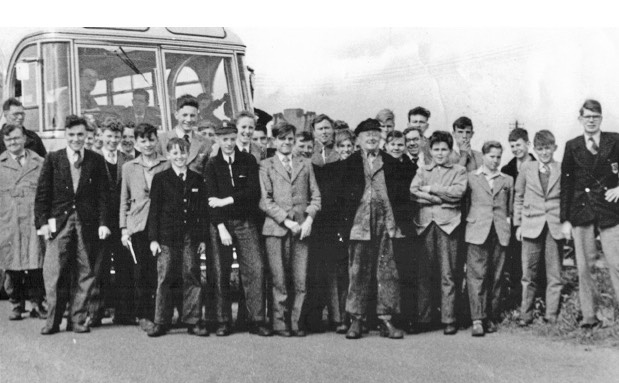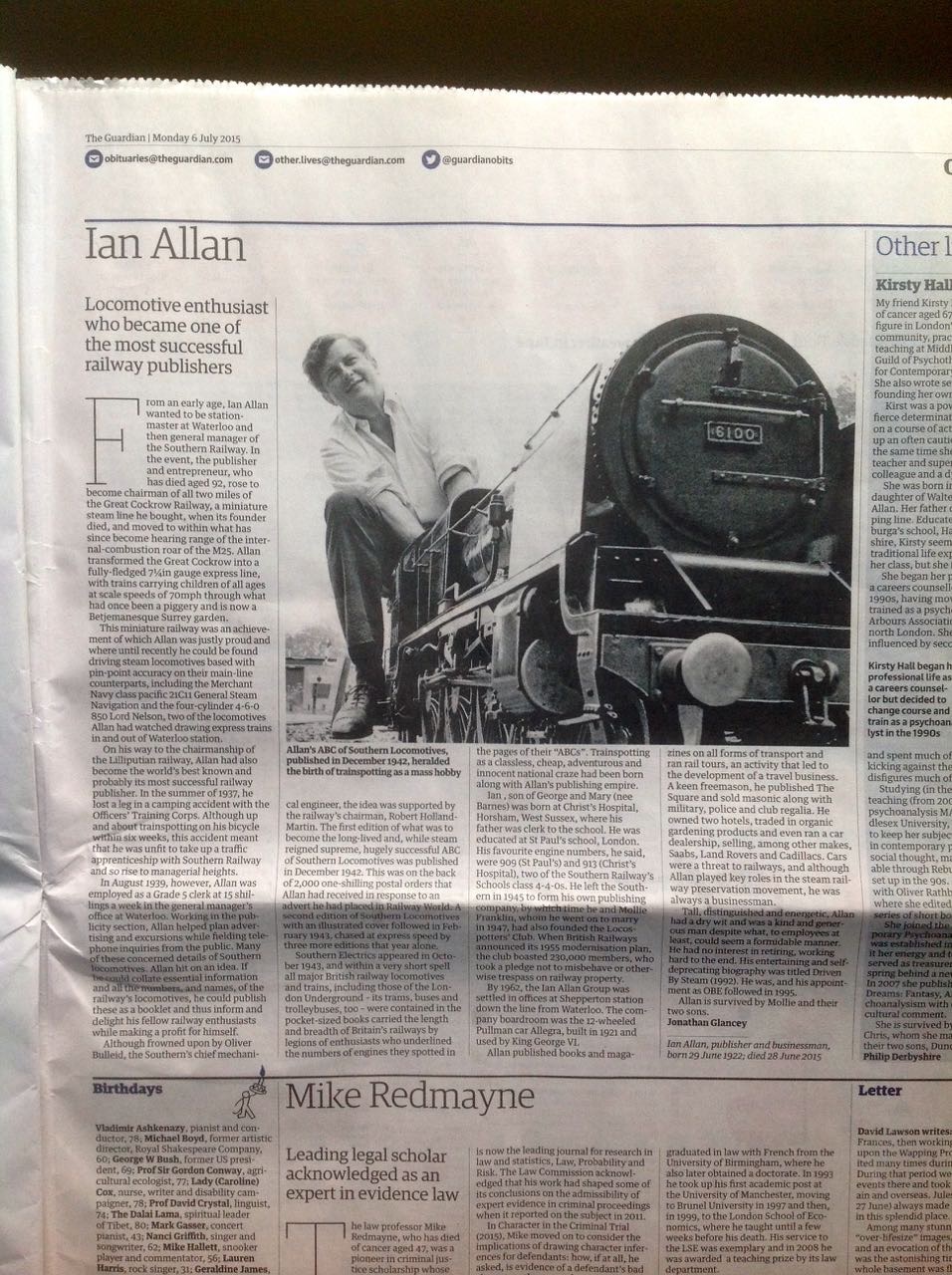
Caption: Oxford Railway Society out on a ‘sheds-visiting’ coach trip, probably in about 1953(**). I look about 12 or 13 (in front of the coach, just to the right of the pillar in the middle of the windscreen, taller than the nearby lads). Michael Crew (Crewe?) is on the extreme RHS, and he organised the trips and everything I believe. He lived in Headley Way, Headington, on the west side of the road, some ten or so houses north of the junction with Woodlands Road - in other words only a five minute walk from our home at 17 Sandfield Road. Lots of other faces I recognise at least a little, but the only one I can name is (surname) ‘Doyle’, who is third person (counting all rows) from the LHS, wearing jacket/tie/pullover and (characteristically!) apparently carrying a notebook in his right hand. On coach trips like this, we just went from engine-shed to engine shed, being conducted around ‘officially’ by arrangement with the management, making records of the locos seen and taking photographs where possible. You could see far more engines in this way than you could see merely by waiting beside a railway line, because it was a feature of steam engines that they had to spend much time at the engine shed being refurbished before their next piece of work.
(**) Updated 24.8.17: actually 1957 and a visit to March (Cambs) engine shed - from a correspondent who contacted me.
Musings:
Yes, well, as my very ‘sporty’ elder brother used frequently to say in those days: “What a bunch of anoraks!” (though that term evolved later, and he used more directly pejorative Anglo-Saxon words. Looking back now, sixty years later, I view my hobby with much affection and pleasure. We were genuinely and intensely interested in (what can now be seen undeniably as) the Indian summer, or its afterglow, of the transport system that was ’the industrial revolution’ of 1825 onwards, and brought the iron age to its end. We were in search of monsters that almost no longer exist. We photographed those monsters while walking around their powerhouses within inches of their infinitely powerful connecting rods and pistons, marvelling at the heat and smoke and ashes and steam and wonderful odoriferous world that they inhabited. We now have photographs of those days, which I treasure and which keep alive that world that is very largely gone. I have ridden on the footplate of a preserved locomotive. It was a good experience, and I am glad to have done so, as I never did so in the days of my youth. But it is so clear to me that these preserved locos are never ‘given their head’ as I know so well was sometimes done in the 1940s and 1950s - meaning ‘opened right up’, just for the sake of it. Sometimes a ‘wheelie’ resulted, meaning infinite wheel slip and an enormous cloud of steam up the funnel and in the sky, without producing very much forward motion (so you could say: ‘what a waste of time and energy’! But what a magnificent sound and sight), and then the driver shut back the regulator and chose the setting that he had known all the time was needed, and accelerated away with a cacophonous repetitive ‘bark’ of steam and smoke at shortening intervals - which in the Oxford of my youth was a characteristic ‘Western’ (meaning GWR/Churchward) bark, that I knew so very well. How wonderful it was, about 50 years later to find out that we actually had a family connection with the great man himself: George Jackson Churchward. Not close. Not a blood-relationship, but only a ‘by-marriage’ link, but a link nevertheless. GJC was of my great-grandfather’s generation, of course. And the man himself was a ‘cousin by marriage’ of my paternal great grandmother, Olive Emma Reed. No one in the family knew this. GJC was a great man. In railway circles, as well known as Brunel himself. His design-influence on locomotives built after his tenure as chief-engineer of the GWR could hardly be greater, both on the GWR itself and on other companies including the LMSR. (pba.28.11.14).
Manchester College, Mansfield Road, off Holywell Street (between Long Wall and Broad Street). You can just see Holywell Street at the LHS in this Christmas Card view of the college. We met in the room reached via the arched entrance visible at the left-hand end of the buildings. The room was, I believe, the one (or one of two) having the mullioned windows seen on the RHS of that entrance. How kind of the Principal to allow us to meet there. I paste this 2014 Christmas Card, from my Unitarian Minister friend Arthur Stewart, in grateful thanks to Dr Garrard, for his generosity. And I provide a link (click here) to an obituary to Dr Garrard, to provide more of his story. It states: “In his study there were always objects illustrating his enthusiasm for railways. Next to a complete run of the Hibbert, there might be a GWR locomotive name-plate, propped up in the fireplace. He seemed almost as familiar with timetables as the apparatus of his Greek Testament."

Here he is. Ian Allen. Effectively the founder of the train-spotting fraternity. An ‘Old Pauline’ (St Paul’s School old-boy), who in 1939 was employed as a Grade 5 clerk at 15 shillings a week in the General Manager’s office at Waterloo station, but became one of the most successful publishers of railway books, starting with a booklet to answer the telephone enquiries he found himself obliged to field in that original clerking job.
Ian Allen’s “ABCs” of locomotives were a sine qua non for us trainspotters. But I thought his name was ‘Jan’ because it was printed on the ABCs in a simulated longhand font in which I thought the first letter of his name was a “J”. Well, well. When I bought my original copies in 1948, Ian Allen’s firm had been going about 9 years, so was well-established, no doubt, but probably had not in any way reached the heights of its publishing achievements. But 1948 wasn’t a bad time to take to the hobby. A few years post World War II. The Labour Government of Clement Atlee (whom I recall was not well-spoken of in our houshold, but whom I now believe to have been a truly great Prime Minister) had just decided that steam, not diesel or electric traction would be the way forward in UK, and had begun the programme of ‘Standard Engine’ (steam engine) building, using designs by their chief engineer (Mr Riddles), using basic designs having much in common with the work of my (then unknown to me as such) family member, GJ Churchward - as modifiied by his (Churchward’s) pupil WA Stanier. For example, the “Brittania” class. Linked to the 1953 Coronation and the 1951 Festival of Britain, and all matters ‘Elizabethan’. Wonderful stuff! A Brittania named “Morning Star”, No.70021 used to come storming through Oxford (heading northwards) at about 4.30 pm every day on the ‘afternoon milk train’ and was indeed a sight to behold.